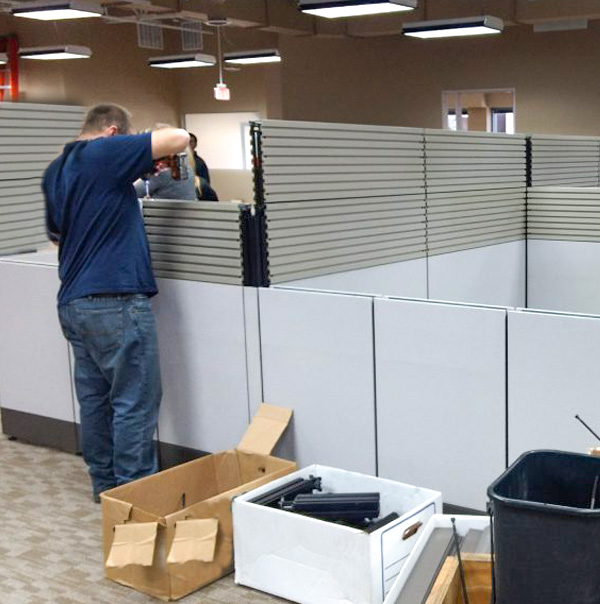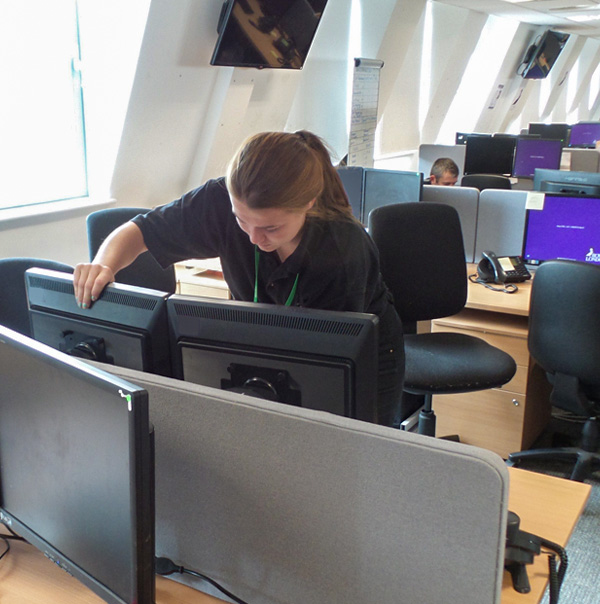Data centers are the backbone of the modern digital economy, enabling businesses to store and process vast amounts of data, facilitate e-commerce transactions, and host mission-critical applications. With the rise of cloud computing, the demand for data centers will only increase in 2023 as more businesses adopt cloud-based solutions to improve their operations and stay competitive.
Executing IT relocations is a complex process that involves careful planning and execution to ensure the seamless transfer of critical data and infrastructure. An IT data center is the backbone of any organization’s digital operations, housing servers, storage devices, networking equipment, and other critical components. Relocating a data center can be necessitated by several factors, including the need for more space, upgrades to infrastructure, or a change in business location.
Regardless of the reason for the move, it is essential to have a comprehensive plan that considers all aspects of the commercial relocation process, including risk mitigation, data security, and minimal downtime. As we move forward, we will look into the intricacies of moving an IT data center and the factors that organizations need to consider to ensure a successful relocation.
Step 1: Assess Your Needs and Develop a Plan
The first step in moving your data center to a new location is to assess your needs and develop a comprehensive plan. The plan should outline the project’s scope, including a detailed inventory of all the hardware, software, and other equipment that will be moved. The plan should also include a timeline for the move and identify potential risks or challenges and strategies for mitigating them.
The planning process should involve a cross-functional team that includes IT professionals, facilities managers, and project managers. The team should work together to ensure that all aspects of the move are carefully planned and executed.
Step 2: Choose Your New Location
Once you have a plan in place, the next step is to choose your new location. The new location should be carefully selected based on factors such as access to power, cooling, and connectivity. The new location should also be able to accommodate your current and future needs, including space for expansion.
When choosing a new location, it is important to consider the following factors:
- Access to power: Your new location should have access to reliable and sufficient power to run your IT infrastructure.
- Cooling: Your data center equipment generates a significant amount of heat. It is important to have an adequate cooling system in place to prevent equipment failure and ensure optimal performance.
- Connectivity: Your new location should have access to high-speed, reliable connectivity to ensure that your IT infrastructure can operate efficiently.
Step 3: Prepare the New Location
Before moving your data center equipment to the new location, you must prepare the space. This involves setting up the necessary infrastructure, such as power and cooling, and ensuring that the space is secure and meets all relevant regulations and compliance requirements.
The preparation process should involve thoroughly assessing the new location to identify potential issues or challenges. It is also important to work with a team of experienced professionals who can help ensure that the new location is ready to receive your data center equipment.
Step 4: Communicate with Stakeholders

Relocating a data center can be a complex and disruptive process that impacts many stakeholders, including IT staff, facilities managers, and end-users. Communication is a critical aspect of the relocation process, as it helps to ensure that all stakeholders are informed of the relocation plans and any potential disruptions or downtime. Effective communication can also help to build trust and confidence among stakeholders and minimize resistance to relocation. This article will explore the importance of communicating with stakeholders during a data center relocation and provide tips for effective communication strategies.
Communication is key during the relocation process. Ensure all stakeholders, including IT staff, facilities managers, and end-users, are informed of the relocation plans and any potential disruptions or downtime.
Step 5: Back Up Your Data
Data is a critical asset for businesses of all sizes, and data centers play a vital role in storing and managing this data. However, data loss or corruption can have severe consequences, including financial loss, damage to a company’s reputation, and legal repercussions. For this reason, it is crucial for data centers to back up their data regularly to ensure that it is protected and can be quickly restored in the event of a disaster.
There are many reasons why data loss can occur, including natural disasters, cyber-attacks, hardware failures, human error, and software bugs. These risks are particularly high in data centers, where large volumes of data are stored in a single location. If data is lost or corrupted, it can be challenging to recover, and the consequences can be severe.
Backing up data is the process of creating a copy of all data and storing it in a separate location, usually offsite. This backup copy can be used to restore data in the event of a disaster or other data loss event. Data centers typically have multiple backup systems, including incremental backups, full backups, and disaster recovery plans, to ensure that data is fully protected and quickly restored.
Before executing IT relocations for your data center, ensure all data is properly backed up and securely transferred to the new location. This will help minimize downtime and ensure that your systems are up and running as quickly as possible.
Step 6: Move the Equipment
Once the new location is prepared, it is time to move the equipment. This process should be carefully planned to minimize downtime and ensure the safe transfer of data and equipment. It is essential to have a team of experienced professionals who can handle the move efficiently and with minimal disruption.
The equipment move should be carefully planned and executed to ensure that all equipment is properly packed, labeled, and transported. The move should be carefully timed to ensure that downtime is minimized and that all systems are back up and running as quickly as possible.
Step 7: Test and Validate the New Environment
After the equipment has been moved, it is important to test and validate the new environment. This involves checking that all systems function correctly and data is transferred securely. It is also important to test the new environment for potential issues or vulnerabilities and make any necessary adjustments.
The testing and validation process should involve a thorough review of all systems and infrastructure to ensure that they are operating as expected. Any issues or vulnerabilities that are identified should be addressed promptly to ensure that the new environment is secure and stable.
Step 8: Go Live
Once you have tested and validated the new environment, it is time to go live. This involves moving your production systems to the new location and ensuring that everything is working as expected. It is important to have a plan in place for managing any potential issues or downtime during the transition.
Step 9: Monitor and Optimize
Once the move is complete, it is important to continue monitoring and optimizing the new environment. This involves regularly checking performance metrics and identifying potential issues or improvement areas. It is also essential to have a plan in place for scaling and expanding the new environment as your needs evolve.
Step 10: Hire Professional Services

A data center relocation can be a daunting and stressful experience, particularly if you are moving a large amount of equipment and other belongings.
Professional movers are experienced and trained to handle all aspects of a relocation, from packing and loading to transportation and unloading. They have the necessary equipment and tools to move your belongings safely and efficiently, minimizing the risk of damage or loss. They are also insured, which means that you are protected if any of your belongings are damaged or lost during the move.
One of the biggest benefits of hiring professional movers is that they can save you time and effort. Packing and loading a large amount of furniture and belongings can be time-consuming and physically demanding, particularly if you are not accustomed to heavy lifting or have health issues. Professional movers can take care of all these tasks for you, allowing you to focus on other aspects of your move.
Benefits of Hiring Professional Movers

Relocating a data center is a complex and challenging process that requires a lot of planning, preparation, and execution. Moving a data center involves much more than just packing up equipment and transporting it to a new location. There are many factors to consider, including the specialized logistics for moving large and heavy equipment, the risk of data loss or corruption, and the need to minimize downtime and disruption to business operations. For this reason, it is essential to hire professional movers for a data center relocation. In this blog, we will explore the benefits of hiring professional moving services for a data center relocation.
Expertise and Experience
A commercial moving company will have the expertise and experience needed to handle all aspects of a data center relocation. They have specialized knowledge in moving and handling data center equipment, including servers, storage devices, and networking equipment. They know how to dismantle and reassemble equipment, transport it safely, and reinstall it in the new location. Professional movers also have the necessary equipment, such as specialized trucks, dollies, and lifting gear, to safely handle heavy and oversized equipment.
Risk Mitigation
Moving a data center involves many risks, including the risk of equipment damage, data loss or corruption, and operational downtime. Professional movers can help mitigate these risks by taking appropriate precautions and following best practices. They can thoroughly assess the equipment and data to identify potential risks and develop a customized plan to minimize them. They can also ensure that all equipment and data are properly labeled, tracked, and secured during the move.
Reduced Downtime and Disruption
One of the biggest challenges of a data center relocation is minimizing downtime and disruption to business operations. Any delay or interruption can significantly impact the business, resulting in lost revenue, reduced productivity, and damage to the company’s reputation. Professional movers understand the importance of minimizing downtime and disruption and can work closely with the IT team to develop a plan that meets the business’s needs. They can schedule the move during off-hours or weekends to minimize the impact on business operations and ensure that the equipment is up and running as quickly as possible in the new location.
Cost Savings
While it may seem counterintuitive, hiring professional movers can actually save money in the long run. Moving a data center is a complex and time-consuming process that requires significant time, resources, and equipment investment. Hiring professional movers can help reduce the time and effort required to move the equipment and data, freeing up the IT team to focus on other aspects of the move. This can result in cost savings by reducing the amount of time required for the move and minimizing the risk of errors or mistakes that can result in costly delays or downtime.
Peace of Mind
Finally, hiring local commercial moving services can provide peace of mind and reduce stress for the IT team and other stakeholders involved in the move. Moving a data center is a high-stress and high-stakes process, and any mistake or error can have significant consequences. By hiring professional movers, IT teams can rely on experts with the experience, knowledge, and equipment needed to successfully handle the move. This can help reduce stress and anxiety and provide peace of mind that the move is being handled correctly.
Have a Seamless Data Center Relocation Experience with Valley Relocation
Commercial data center relocations are a difficult and overwhelming experience, and you need someone who understands the procedures to ensure that the experience is seamless. To simplify the procedure, check out our local commercial moving company, Valley Relocation, for a seamless commercial move.
At Valley Relocation, we offer a range of services meant specifically for your business, including temporary commercial storage, facility services, IT equipment movers, climate-controlled shipping, and much more. Make sure to get in touch with us today for more information about our services.






